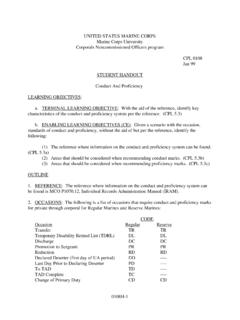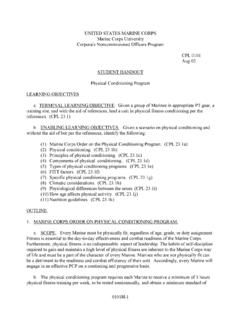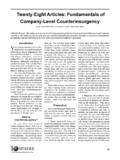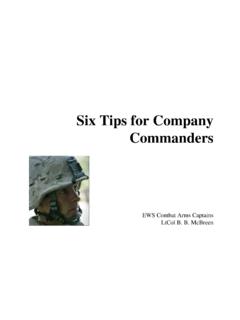Transcription of Cpl 0205 SH - Militarytraining.net
1 UNITED STATES MARINE CORPSM arine Corps UniversityCorporals Noncommissioned Officers ProgramCPL 0205 Jan 99 STUDENT HANDOUTL eadership StylesLEARNING LEARNING OBJECTIVE : With the aid of the references, identify theMarine Corps' Leadership fundamentals, per the references. (CPL ) LEARNING OBJECTIVE (CE): Without the aid of but per the reference,identify the following:(1)The leadership styles. (CPL )(2)The leadership style variations. (CPL )(3)The factors influencing leadership styles. (CPL ) STYLES:a. Definition: Leadership style is defined as the leader's behavior pattern as perceived by hisMarines when he is attempting to influence, guide, or direct their activities. Therefore, yourleadership style is not always determined by what you think it is, but many times by how yoursubordinates think you lead. A leader must be constantly aware of this perception and know howto best approach subordinates in each given Different Leadership Styles:(1)Autocratic: The autocratic style is where the leader makes all decisions for hissubordinates and tells them what to do, how, when, where, etc.
2 (See Figure 0205-1)(2)Democratic: The democratic style is where the leader allows his subordinates tomake their own decisions within general or mission type guidelines set by the senior. (See Figure0205-1)0205H-1 Figure VARIATIONS: Between these two extremes are variations. These leadership stylevariations depend on how much authority and direction is either kept by the leader or is delegatedto the subordinate. For the sake of discussion we can divide the continuum into four "basic"styles. As we discuss these four style variations remember that there are varying degrees of thebasic styles based on the exact amount of authority the leader desires to use or delegate. Aparticular style of leadership might not be successful everywhere and might not be used effectivelyfor everyone. What seems to be a "telling," or authoritarian style to one individual/group may beinterpreted more like a "selling," or persuasive style to another.
3 Sometimes we all need to be"told" what to do because our motivation, understanding, or experience level is low; at othertimes all we need is a mission to get us going. For example, your leadership must be consistentbut your style should be flexible, what is effective in one situation may not get the same positiveresults in a similar situation at another time and Style: This is characterized by one-way communication where the leader defineshis followers' roles by "telling" them what to do, when to do it, how to do it, and where to do example, it is very natural and intelligent to expect a leader to assume a very authoritarian"telling" style during a fire fight, or crisis situation; in fact our subordinates expect their leaders to0205H-2react on a forceful and decisive manner during these situations. It might be inappropriate for aleader to assume this "telling" style during a staff planning exercise when the objective is for thegroup to work out a complex plan ensuring that all points are covered.
4 This style would beparticularly incorrect if the staff was experienced and capable. To use a "telling" style in this casewould show a lack of faith in their ability, demotivating them. I would not allow them to use theirtotal "human resource" in developing the Style: The leader uses two-way communication to gain his followers' support byexplaining the reasoning behind his decision. This style allows the subordinates minimalparticipation, but helps them to better understand and hopefully "buy into" the leader's this case the leader is explaining why he made the decision and then tries to "sell" the decisionto the group by using persuasion. By taking them into his confidence relative to his decision, hewill gain their support for his plan and they will be more motivated to go along with the Style: The leader allows the subordinates to be involved in the actualdecision making process. It requires good two-way communication and the leader's willingness tobe influenced by his subordinates' knowledge and opinions.
5 Here the leader actually discussespossible alternative solutions with the group prior to making his decision. An example of thiswould be a battalion commander discussing his staff's "estimates" prior to selecting a course ofaction, or a company first sergeant discussing with the company SNCO's how they should preparefor a battalion Style: The leader provides mission-type orders/guidelines and minimalsupervision. Essentially, the group is allowed to run its own show within the limits provided bythe leader. The leader has provided his subordinates their limits, guidelines, and necessaryauthority to complete the task; he then gives them their mission, and allows them to accomplishthe mission as they see fit. An example here is the company commander turning over the weeklyfield day to the company gunnery sergeant. The company gunnery sergeant knows what needs tobe done, when it's to be done, the expectations of the commanding officer, and the resourcesavailable.
6 Now he formulates his own plan of execution and accomplishes the task as THAT INFLUENCE LEADERSHIP STYLES: Some of the factors that canaffect a leader's style are: the individual or group being led, the mission, the situation, and ofcourse the leader himself. Let's look at each of these factors in a little more The Individual or Group Being Led: When evaluating the individual or group that you aregoing to lead there are some very critical areas that you must carefully consider. These areas aretheir abilities, experience, training, willingness, interest, motivation, unitsize/composition/organization, and expectations.(1)Ability, Experience, and Training: The greater the ability of the individual or groupto accomplish the task or mission, the less direct supervision and guidance is required from theleader. A platoon sergeant who knows that squad Leader "A" knows how to properly preparehis squad for an inspection and is dependable, would not have to supervise that squad leader very0205H-3closely, but squad Leader "B" who is less experienced, would probably require more supervisionto achieve the same results.
7 (2)Willingness, Interest, and Motivation: The greater the willingness to accomplish thetask or mission, the less "forceful" the leader needs to be. An individual's or group's motivationlevel will determine how much "push" and supervision the leader needs to exert to get the jobdone. The less the motivation, the more "push" is necessary.(3)Size, Composition, and Organization: As the size of the group increases, the morediverse the group becomes relative to ability and interest, and the greater the need fororganization. In line organizations, this is not much of a problem, because as the unit sizeincreases, the chain of command structure is designed in most cases to maintain the three to oneratio. The problem does increase when the leader deals directly with larger numbers of personnel,such as in a classroom environment of a headquarters staff type unit.(4)Expectations: What type of leadership style does the group expect from its leaders ?
8 This can be important during transition periods between leaders . If the "old leader" was primarilya "participator" and your predominate tendency is to be a "teller," you must be aware that duringthe transition period there may be some confusion and difficulty in the communication processbetween yourself and your subordinates because of the difference in styles that they are used Mission: The more complex the requirement, the greater the need for specificdirection from the leader as to who does what, to whom, when, why, and how. If a task requiresvery specific coordination and attention to a specific plan, then the leader does not have muchchoice in style, he simply must "tell" his subordinates how, who, what, and when it will be Situation: The shorter the time available to accomplish a task, the more directive aleader should be. In crisis situations leaders are expected to take charge and make is little time for discussions during fire fights or emergency situations.
9 During crisissituations subordinates look to their leaders for direction and expect concise orders, Leader: The leader's personal values will affect his natural tendencies. The leader'sdegree of confidence will also be a key factor. The more confidence a leader has in the group orindividual the less will be his tendency to direct how to accomplish a task. The self confidencelevel of a leader plays a critical part as well. The less confident a leader feels about himself themore likely he will be directive in nature. The less confident leader will usually go step-by-stepuntil he feels he knows everything is going along properly. All of us have a natural leadershipstyle that we feel more comfortable with. It is important to be ourselves and not attempt toassume a style that is not natural as it tends to confuse our subordinates. By recognizing ournatural tendency, we can evaluate this predominate style more accurately, and when the situationrequires a shift in leadership style, accomplish it more : Marine Corps Values and Leadership User s Guide for Discussion Leaders0205H-4







